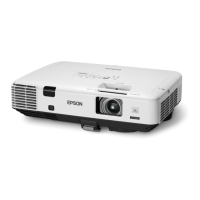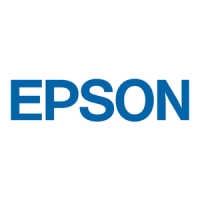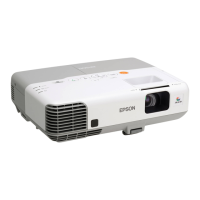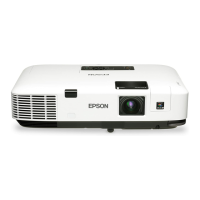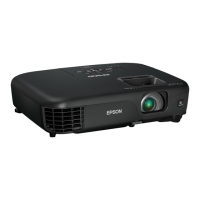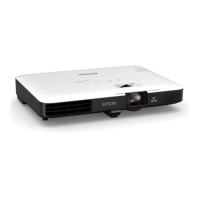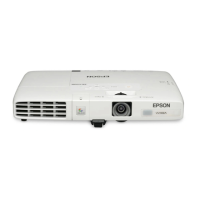Do you have a question about the Epson PowerLite 1940W and is the answer not in the manual?
Details the key features of the PowerLite projectors, including resolution and connectivity.
Lists all items included in the projector's packaging for user verification.
Provides resources for help and further details about the projector.
Guidance on choosing an optimal location for projector installation, considering ventilation and access.
Information on determining projector placement for desired image size based on projector model.
Instructions for connecting the projector to a wired network for projection and control.
Steps for setting up wireless projection using the projector's network features.
Procedure for powering on the projector and preparing it for use.
Methods for correcting projected image geometry for optimal display.
Explains how to use the remote control for projector functions and operation.
How to use zoom features to focus attention on specific parts of the image.
Overview of security options like Power On Protect and User's Logo Protect.
Instructions for disabling the projector's control panel buttons.
Options for fine-tuning image quality parameters like brightness and contrast.
How to configure settings related to the input video signal.
Common solutions for issues related to projected images and audio output.
Troubleshooting steps to resolve the issue of no image being displayed.
Detailed technical data for the projector's core components and performance.
List of compatible video resolutions and refresh rates for optimal display.
Crucial safety precautions for operating and handling the projector.
Detailed safety guidelines to prevent injury and equipment damage.
Details the key features of the PowerLite projectors, including resolution and connectivity.
Lists all items included in the projector's packaging for user verification.
Provides resources for help and further details about the projector.
Guidance on choosing an optimal location for projector installation, considering ventilation and access.
Information on determining projector placement for desired image size based on projector model.
Instructions for connecting the projector to a wired network for projection and control.
Steps for setting up wireless projection using the projector's network features.
Procedure for powering on the projector and preparing it for use.
Methods for correcting projected image geometry for optimal display.
Explains how to use the remote control for projector functions and operation.
How to use zoom features to focus attention on specific parts of the image.
Overview of security options like Power On Protect and User's Logo Protect.
Instructions for disabling the projector's control panel buttons.
Options for fine-tuning image quality parameters like brightness and contrast.
How to configure settings related to the input video signal.
Common solutions for issues related to projected images and audio output.
Troubleshooting steps to resolve the issue of no image being displayed.
Detailed technical data for the projector's core components and performance.
List of compatible video resolutions and refresh rates for optimal display.
Crucial safety precautions for operating and handling the projector.
Detailed safety guidelines to prevent injury and equipment damage.
| Number of colors | 16.78 million colors |
|---|---|
| Native aspect ratio | 16:10 |
| Projection distance | - m |
| Projection technology | 3LCD |
| Contrast ratio (dynamic) | 3000:1 |
| Contrast ratio (typical) | - |
| Screen size compatibility | 29 - 280 \ |
| Projector native resolution | WXGA (1280x800) |
| Keystone correction, horizontal | -30 - 30 ° |
| Focus | Manual |
| Zoom capability | Yes |
| Focal length range | 18.2 - 29.2 mm |
| Aperture range (F-F) | 1.51 - 1.99 |
| Lamp type | UHE |
| Lamp power | 245 W |
| Light source type | Lamp |
| Service life of light source | 2500 h |
| Service life of light source (economic mode) | 4000 h |
| Full HD | No |
| Supported video modes | 1080i, 1080p, 480i, 480p, 576i, 576p, 720p |
| Analog signal format system | NTSC, PAL, SECAM |
| RMS rated power | 10 W |
| Number of built-in speakers | 1 |
| USB connector type | USB Type-A, USB Type-B |
| Serial interface type | RS-232 |
| USB 2.0 ports quantity | USB 2.0 ports have a data transmission speed of 480 Mbps, and are backwards compatible with USB 1.1 ports. You can connect all kinds of peripheral devices to them. |
| USB 3.2 Gen 1 (3.1 Gen 1) Type-A ports quantity | 0 |
| Ethernet LAN data rates | 10, 100 Mbit/s |
| Noise level | 37 dB |
| Noise level (economic mode) | 29 dB |
| Placement | Desktop, Ceiling |
| Product type | Standard throw projector |
| Product color | White |
| Cable lock slot type | Kensington |
| Power source | AC |
| AC input voltage | 100 - 240 V |
| AC input frequency | 50 - 60 Hz |
| Power consumption (standby) | 3.8 W |
| Power consumption (typical) | 311 W |
| Storage temperature (T-T) | 5 - 35 °C |
| Weight | 3900 g |
|---|
